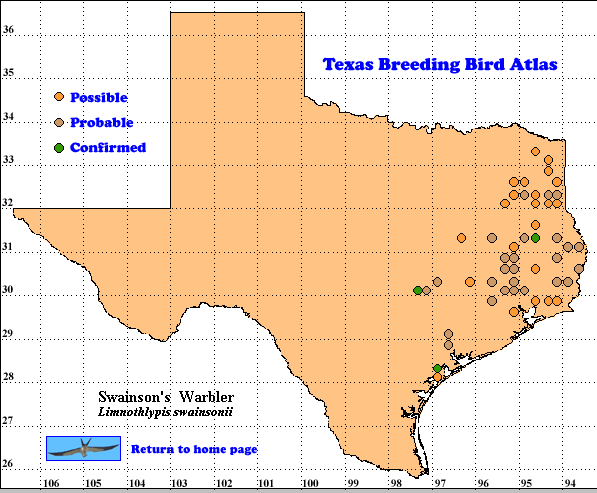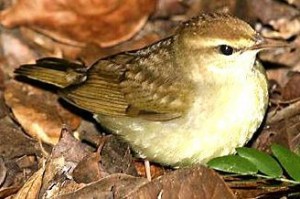The Swainson’s Warbler is an uncommon summer denizen of thick undergrowth in creek and river bottoms of east Texas and the southeastern United States, in addition to mountain rhododendron and laurel thickets in the Appalachian Mountains, and rarely in upland thickets in other areas, such as in the Ozark Mountains (Bent 1953). Only persistent observers see this species, as it is a very reclusive bird that seems to shun open spaces and direct sunlight. A males presence in the deepest, darkest thickets is revealed, however, by its clear, spine-tingling song that can be heard from about 90 m (100 yd) away. At close range, perhaps within 6 m (20 ft), a piercing quality to the otherwise sweet notes, is evident. The song is most often described as a loud, clearly whistled wee wee wee whip-poor-will or seer seer seer whip-poor-weeo, delivered with the long, spiky bill pointing almost vertically. The song is very captivating, even to those who do not necessarily appreciate bird song, and is said by many to be the best among the wood warblers. One fortunate enough to wander near a singing male is almost certain to be stopped in his tracks to enjoy the melody.
The Swainson’s is a dead leaf specialist, feeding primarily on caterpillars, other insects, and spiders found on the ground in leaf litter (Brown and Dickson 1994). Its drab coloration helps to camouflage this skulker as it walks about in search of prey. While foraging, its walking style is a series of jerky starts and stops, often with its entire body vibrating noticeably as its feet are shuffled rapidly to flush prey (GGL). The bird is 12.7-16.5 cm (5-6.5 in.) long; sexes look alike, brown and olive above with a russet or brownish cap, conspicuous white eye-stripe, dingy white to slightly buff underparts, no wing-bars, and a relatively long, spike-like bill (Brown and Dickson 1994)
DISTRIBUTION: Breeding season records of Swainson’s Warbler in Texas generally range from the northeast corner of the state in Bowie County (latilong 33094, quad C6), roughly southwestward through Smith, Anderson, and Robertson counties to Bastrop County (latilong 30097, quads A2 and B4), then southward through Gonzales County to the middle Texas coast in Aransas County (latilong 28096, quads B7, B8, Cl, C8, and G5). Confirmed breeding during the years of the TBBA field work (1987-1992) occurred in only four instances, due in large part to the bird’s predilection for nearly impenetrable habitat that is formidable to most humans: twice in latilong 28096 in quad Cl, and once each in latilong 30097 in quad B4 and in latilong 31094 in quad D5.
SEASONAL OCCURRENCE: Swainson’s Warblers generally begin arriving along the Gulf Coast in spring migration in early April, but late March sightings are not unusual. The earliest record for Texas is March 2 (Oberholser 1974). Males are normally singing on territory in their bottomland habitat in east Texas by mid-April (GGL). A male will often sing for several minutes from one spot, normally from a low perch, with the song usually repeated every 10-15 seconds while establishing and maintaining a territory. Sometimes, however, the song is delivered on an even shorter frequency, with very little pause between each song. Singing continues for maybe 30 minutes, then the bird may forage for a period of time before beginning another bout of song. Breeding dates range from approximately mid-April until at least mid-July in Texas. The four confirmed records during the years of the TBBA project were of parents feeding young on June 17 and 24 and of fledged birds on June 26 and July 19. Fall migration probably begins in August, and the latest sighting on record of the species in Texas is October 21 (Oberholser 1974). Birds winter in the northern Bahamas, Cuba, Jamaica, southeast Mexico, and Belize (Morse 1989).
BREEDING HABITAT: The Swainson’s Warbler inhabits thick undergrowth in creek and river bottoms in east Texas. The undergrowth can be comprised of giant cane (Arundinaria sp.) and/or a mixture of nearly impenetrable deciduous bushes and small trees. Palmetto (Sabal sp.) can make up a significant amount of the understory, mainly in southern east Texas (GGL) The nest is usually concealed from 0.6-3 m (2-10 ft) above ground in a thicket, be it a bush, low tree, tangle of vines, or stand of cane, and is surprisingly large for a warbler (Ehrlich 1988). It is often placed at the edge of the male’s singing territory, sometimes even outside that territory. The nest is loosely constructed of leaves, mosses, and pine needles, and is lined with fine grasses. It is built by the female, who also does the incubation and is a close sitter on eggs. Three eggs are usually laid, but sometimes four or rarely five are laid. Eggs are normally white, rarely spotted, and have a slight gloss. This is the only U. S. warbler that typically lays white, unmarked eggs, except for the Bachman’s Warbler, which is now possibly extinct. Incubation lasts 13-15 days, and fledging occurs in another 10-12 days (Harrison 1975).
STATUS: Overall, the Swainson’s Warbler is an uncommon breeding bird in east Texas. In extensive areas of its preferred habitat, however, it can be reasonably common, with breeding pairs spaced perhaps less than 150 m (165 yd) apart along a creek or river with thick undergrowth (GGL). In northern Rusk County about 16 kin (10 mi) south of Longview in the summers of 1992-1994, three singing males have consistently been heard along an approximate 180 m (200 yd) stretch of Bacon Creek. An approximate 1.6 km (1.0 mi) hike downstream from the south side of the FM 1794 bridge over the Sabine River in northern Panola County on June 9,1991 produced eight singing males. The species has also been heard singing in mid-summer in thick, second-growth bottomland that had been clearcut an estimated four to five years earlier (GGL). Therefore, bottomland thickets appear to be necessary for the Swainson’s Warbler in east Texas, but it may not matter that the thick vegetation is within older growth forest.
TBBA data indicate that the breeding range in Texas has remained essentially unchanged through the latter half of the 20th century (Oberholser 1974). Owing to the bird’s secretive nature, however, it is very difficult to draw conclusions regarding changes in the species’ abundance in cast Texas over time.Text by Guy G. Luneau (Posted with updates 2007)
 Literature cited.
Literature cited.
Bent, A. C. 1953. Life Histories of North American wood warblers. U. S. Natl. Mus. Bull. 203.
Brown, R. E. and J. G. Dickson. 1994. Swainson’s Warbler (Limnothlypis swainsonii). In The birds of North America, No.12 1 (A. Poole and F. Gill, eds.). The Birds of North America, Inc., Philadelphia, PA.
Ehrlich, P. R, D. S. Dobkin, and D. Wheye. 1988. The Birder’s Handbook. Simon and Schuster, New York.
Harrison, H. H. 1975. Birds’ Nests. Peterson Field Guides. Houghton Mifflin Company, Boston.
Morse, D. H. 1989. American warblers: an ecological and behavioral perspective. Harvard University Press, Cambridge, MA.
Oberholser, H. C., 1974. The bird life of Texas. University of Texas Press, Austin.
